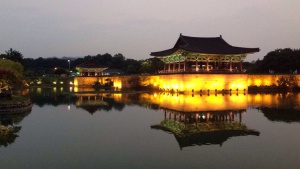With the AKS programme, we left on a three day fieldtrip to Gyeongju. Gyeongju is located in the North Gyeongsang Province and is also better known as the 'museum without walls' as many historical sights have been kept intact. It was the capital of the Silla kingdom (57 BC - 935 AD).
Day 1
After leaving AKS, we made a stop in the Korean Folk Village in Yongin. This is a village that takes you back in time as it has relocated and restored traditional buildings. Walking around this village makes you feel like you're walking around in a real Joseon village.

The view once the sun started setting.
We watched a Salmunori performance and a traditional wedding ceremony there before heading off to Gyeongju. Once we arrived in Gyeongju, we visited the Anapji Pond. This is an artificial pond in Gyeongju National Park which used to be part of the palace complex of the Silla kingdom and was constructed under King Munmu. At the pond, we watched a light show that showed the transitional contrast between two breathtaking views - the traditional buildings during day and night time.
Day 2
We started the day with a visit to the Cheonmachong tomb which is part of the Daereungwon Tomb Complex. The name refers to the only discovered painting from the Silla era which shows a Korean pegasus (a Cheonma) with eight legs and wings on its feet. As the remains of the king had decayed, it was unsure to which king the tomb belonged to. Later, we headed to the Chumsungdae which is the oldest surviving astronomical observatory in East Asia. We ended the morning with a visit to the Gyeongju National Museum which held a huge amount of relics of the Silla kingdom. The main attraction for me was the Bell of King Seongdeok. According to the legend, the first bell that was made produced no sound when it was struck. Countless other bells were created

At the pillar-shaped joint.
after the first one but none of them were able to produce a sound - only after a child was cast into the metal, was the bell able to produce the most beautiful sound when struck. Later that day, we also visited the underwater tomb of king Munmu where his ashes were spread out and the pillar-shaped joint.
Day 3
To end the trip, we went to the Bulguksa temple which was built under king Beopheung. In the temple, we also visited Seokguran which overlooks on the Donghae and was built during the cultural peak of Unified Silla. The many Buddha statues were grotesque and very impressive. This was the end of our educative trip to Gyeongju. It was really interesting to see all these sights from such a long time ago, especially with the emphasis on Buddhism and shamanism.


